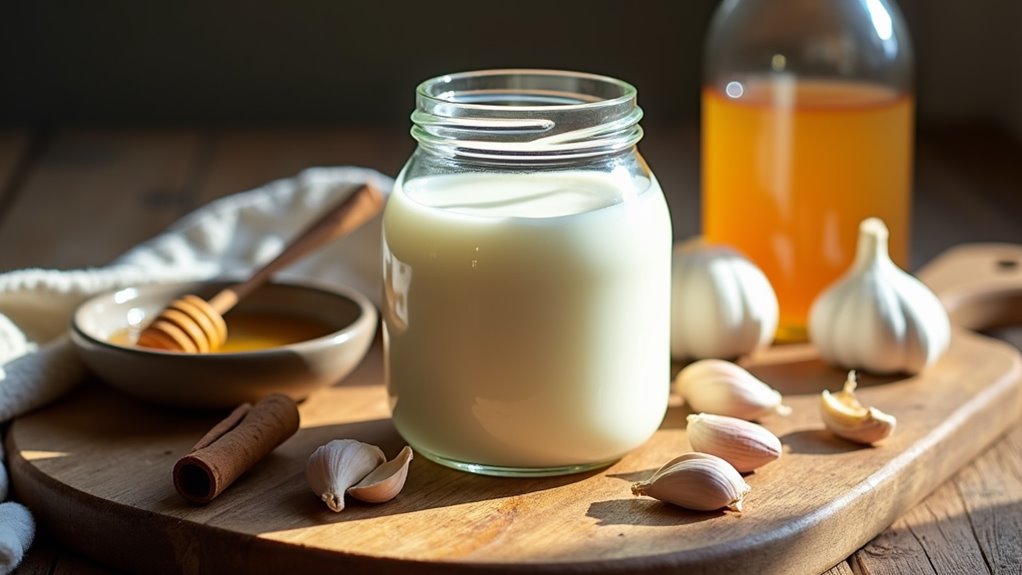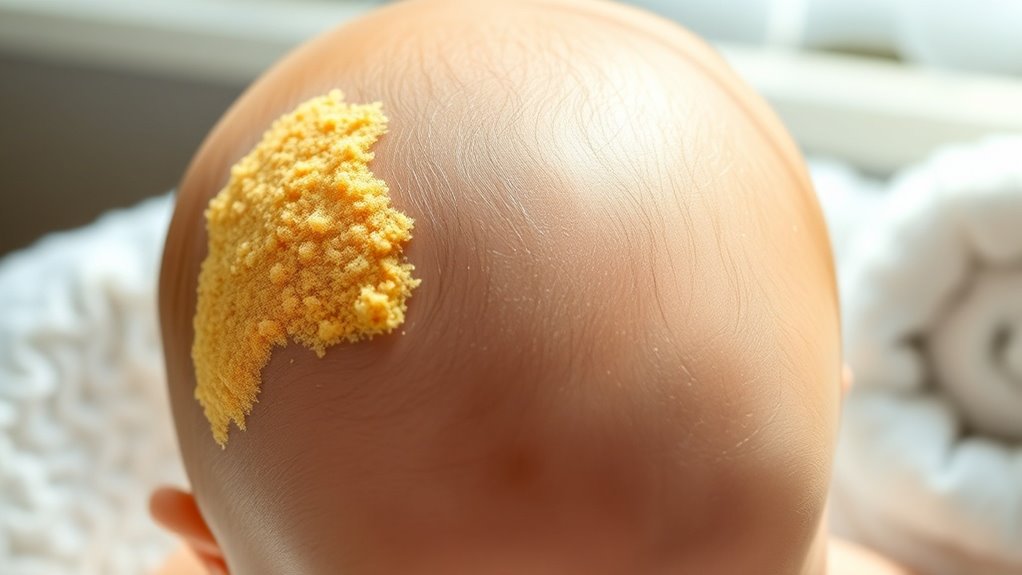Kids Beg for This Delicious Cough Remedy!
Say goodbye to battles over bitter cough medicine! You’ll love this kid-approved remedy that combines raw honey, fresh lemon juice, and optional warming spices like cinnamon or ginger. Simply mix these natural ingredients to create a sweet, soothing syrup that children actually enjoy taking. Not only does it taste great, but honey’s proven effectiveness rivals over-the-counter medications. Discover how to make this magical mixture that’ll have your little ones asking for more.
Key Takeaways
-
Raw honey’s natural sweetness makes it a delicious alternative to bitter traditional cough medicines that kids often resist.
-
Creating frozen “cough pops” with honey-lemon mixture in fun-shaped molds transforms medicine into an exciting treat.
-
A “magic potion station” allows kids to participate in making their remedy, increasing their enthusiasm for taking it.
-
Adding kid-friendly flavors like cinnamon or star anise creates a tasty drink that masks medicinal properties.
-
Serving the remedy in themed cups with silly straws makes the experience fun and encourages children to drink it.
Why Traditional Cough Medicines Turn Kids Away
Why do most children wrinkle their noses at the mere mention of cough medicine? It’s no secret that traditional cough remedies for kids often come with an unpleasant, bitter taste that leaves them running in the opposite direction.
You’ve probably experienced the struggle firsthand – trying to convince your little one to take their medicine while they’re putting up quite the resistance. The artificial cherry or grape flavoring doesn’t fool anyone, especially not your smart kids. They can detect that medicinal aftertaste from a mile away.
The thick, syrupy texture doesn’t help either. When you combine that with the strange chemical smell and artificial colors, you’ve got a recipe that makes most children dread their next dose.
No wonder finding kid-friendly alternatives has become every parent’s mission.
The Magic of Honey as Nature’s Cough Suppressant
When it comes to natural cough remedies, honey stands out as nature’s golden solution for soothing your child’s irritated throat.
You’ll find that a spoonful of honey not only tastes delicious but also creates a protective coating that calms coughing and reduces throat inflammation.
Many parents in our community swear by raw honey’s effectiveness, backed by research showing it works better than over-the-counter medications.
You can offer your little one a teaspoon of honey before bedtime or mix it into warm herbal tea for enhanced benefits.
Just remember not to give honey to babies under 12 months old.
For best results, choose organic, unprocessed honey from your local farmer’s market.
You’ll join countless other parents who’ve discovered this sweet secret to helping their children feel better naturally.
Essential Ingredients for Your Child-Friendly Remedy
Three key ingredients form the foundation of this kid-approved cough remedy: honey, fresh lemon juice, and warm water.
You’ll want to choose raw, unprocessed honey for its maximum therapeutic benefits. Local honey works best since it contains traces of regional pollen that can help build immunity.
Fresh lemon juice adds vitamin C and natural antibacterial properties to your mixture.
Don’t use bottled lemon juice – the fresh stuff packs more punch and tastes better to little ones.
When you’re ready to combine everything, use water that’s warm but not hot, so your child can drink it right away.
You can customize this base recipe by adding a pinch of ginger or a dash of cinnamon, making it even more appealing to your young one’s taste buds.
[DIRECTIONS]:
Kitchen Tools You’ll Need
Getting these simple ingredients ready requires just a few basic kitchen tools you probably already have at home.
You’ll need a medium-sized saucepan for heating the mixture, plus a wooden spoon for gentle stirring. Keep a measuring cup and measuring spoons handy to guarantee precise portions.
Don’t forget to grab a fine-mesh strainer to remove any herb pieces or pulp, and a glass jar with a tight-fitting lid for storage.
If you’re making the remedy with honey, you’ll want a heat-safe bowl for mixing. A citrus juicer comes in handy if you’re using fresh lemons, and a small funnel helps prevent spills when transferring the finished remedy to your storage container.
Age-Appropriate Dosage Guidelines
Safe dosing is essential when giving any natural remedy to children.
You’ll want to adjust the amount based on your child’s age and weight to guarantee both safety and effectiveness.
For children ages 1-3, start with 1/2 teaspoon of the remedy up to three times daily.
Kids ages 4-7 can take 1 teaspoon three times daily, while those 8-12 can have up to 1.5 teaspoons per dose.
Children over 12 may take the adult dose of 2 teaspoons.
Don’t give this remedy to infants under 12 months without consulting your pediatrician first.
If symptoms persist beyond 5 days or worsen, seek medical attention.
Always measure precisely using the proper measuring spoons – kitchen spoons aren’t accurate enough for medicinal doses.
Step-by-Step Preparation Method
Making this natural cough remedy requires minimal ingredients and basic kitchen tools you likely have at home.
You’ll need honey, lemon, ginger, and a clean glass jar with a tight-fitting lid.
Start by slicing one fresh lemon and one thumb-sized piece of peeled ginger into thin rounds.
Layer these in your jar, alternating between lemon and ginger.
Pour honey over the layers until the jar is full, making sure all ingredients are completely covered.
Let the mixture sit at room temperature for two hours, then store it in your refrigerator.
When your child needs relief, stir the mixture and give one teaspoon of the liquid portion.
The honey will have absorbed the beneficial compounds from both the lemon and ginger, creating a soothing syrup your kids will love.
Adding Natural Flavors Kids Love
While the basic honey-lemon-ginger remedy works well, you can enhance its appeal by incorporating kid-friendly natural flavors.
Try adding a few drops of pure vanilla extract for a comforting, dessert-like taste that’ll make your little ones forget they’re taking medicine.
Cinnamon adds warmth and sweetness that most kids adore, while a touch of fresh orange juice brings a familiar fruity twist.
For picky eaters, you’ll find success with a few fresh berries muddled into the mixture.
Strawberries and blueberries not only boost vitamin C but also create an appealing color that makes the remedy more inviting.
If your child enjoys mint, adding a few crushed fresh mint leaves can create a cool, revitalizing sensation that helps soothe scratchy throats.
Storage and Shelf Life Tips
Proper storage of your homemade cough remedy guarantees it stays fresh and effective for your child.
You’ll want to keep your mixture in an airtight glass container, away from direct sunlight and heat. The best spot is in your refrigerator, where it’ll maintain its potency for up to two weeks.
Like other caring parents, you can extend the shelf life by adding a tablespoon of raw honey, which acts as a natural preservative.
If you notice any change in color, smell, or consistency, it’s time to make a fresh batch.
Don’t forget to label your container with the date you made it – this simple step helps you track freshness.
For convenience, you can portion the remedy into small, sterilized jars to keep one at home and another at grandma’s house.
When to Give This Remedy
Now that you’ve prepared and stored your remedy, knowing the right time to give it to your child will maximize its effectiveness. Like other parents who’ve found success with this remedy, you’ll want to establish a consistent schedule.
| Symptom | Best Time | Dosage |
|---|---|---|
| Dry Cough | Before bed | 1 teaspoon |
| Wet Cough | Morning & night | 2 teaspoons |
| Sore Throat | Every 4 hours | 1 teaspoon |
| Congestion | With meals | 1 teaspoon |
| Nighttime Cough | 30 min before sleep | 2 teaspoons |
You’ll notice your child’s symptoms improve most when you’re consistent with timing. Many parents in our community have found that keeping a simple dosage log helps track their child’s response to the remedy. Remember to always start with the smallest recommended dose and adjust as needed.
Signs Your Child Needs Medical Attention
Although natural remedies can help ease your child’s cough, you should watch for warning signs that indicate the need for professional medical care.
Contact your pediatrician if your child has difficulty breathing, shows signs of dehydration, or develops a fever over 102°F.
Other concerning symptoms include coughing up blood, making whooping sounds while breathing, or experiencing chest pain.
You’ll also want to seek immediate care if your child’s lips or fingernails turn bluish, or if the cough persists for more than two weeks.
Trust your parental instinct – if something doesn’t feel right about your child’s condition, don’t hesitate to call your healthcare provider.
They’re there to help guarantee your little one gets the care they need when natural remedies aren’t enough.
Herb and Spice Options for Extra Benefits
Many herbs and spices can enhance your child’s cough remedy while providing additional health benefits.
You’ll love adding ground turmeric for its powerful anti-inflammatory properties, or sprinkling in some ground ginger to help soothe sore throats and reduce nausea.
Cinnamon isn’t just delicious – it’s packed with antioxidants and can help fight bacteria. Your little one might also enjoy the sweet licorice taste of star anise, which helps loosen mucus.
Consider adding fresh thyme, known for its expectorant qualities that help clear congestion.
For a milder flavor that still packs healing power, try chamomile or sage. These gentle herbs calm irritated throats and can help your child rest better.
Remember to start with small amounts of any new ingredient to verify your child enjoys the taste and tolerates it well.
Common Mistakes to Avoid
While making homemade cough remedies can be rewarding, several common mistakes could reduce their effectiveness or even harm your child.
Don’t heat honey to boiling temperatures, as this destroys its beneficial properties. You’ll also want to avoid using raw honey for infants under 12 months due to botulism risks.
Another mistake is adding too many ingredients, thinking they’ll work better together. This can overwhelm your child’s taste buds and make them refuse the remedy. Stick to 2-3 proven ingredients for the best results.
Don’t store your remedy for more than 48 hours at room temperature.
Even in the refrigerator, it’s best to make fresh batches every 3-4 days to guarantee maximum effectiveness and prevent potential bacterial growth.
Making It Fun: Creative Serving Ideas
Getting kids to take medicine doesn’t have to be a battle. You can transform your homemade cough remedy into an exciting treat that your little ones will actually look forward to taking.
Serve the remedy in colorful silicone popsicle molds for a soothing frozen treat. Pour it into fun-shaped ice cube trays and add it to their favorite juice. Use silly straws with loops and swirls to make sipping more entertaining.
Create a “magic potion station” with measuring cups and child-safe droppers, letting them be part of the process.
For older kids, try serving it in themed cups featuring their favorite characters, or blend it into a smoothie they can help make.
Remember to always maintain the correct dosage while making these creative adjustments.
Scientific Evidence Behind Natural Ingredients
Research consistently validates the therapeutic properties of traditional cough remedy ingredients. You’ll find that honey, studied extensively by pediatric researchers, shows significant effectiveness in soothing coughs and supporting immune function.
Clinical trials have demonstrated that dark honey outperforms many over-the-counter medications for nighttime cough relief.
Your grandmother was right about ginger and lemon too. Studies confirm ginger’s powerful anti-inflammatory properties, while lemon’s vitamin C and antioxidants enhance immune response.
These natural ingredients work synergistically – meaning they’re more effective together than alone. When you combine them with herbs like thyme, which contains compounds proven to relax throat muscles and reduce inflammation, you’re using science-backed solutions that generations have trusted.
The evidence supports what traditional healers have known for centuries.
Seasonal Variations of the Recipe
As seasons change throughout the year, you’ll need to adapt your cough remedy ingredients for maximum effectiveness.
During spring, you can add local honey and fresh elderberry to combat seasonal allergies and strengthen immune response.
Summer’s recipe works best with cooling peppermint and freshly squeezed lemon, while adding a touch of ginger helps fight summer colds.
When autumn arrives, switch to warming spices like cinnamon and nutmeg, paired with apple cider as your base.
Winter’s version calls for extra honey, fresh thyme, and a pinch of cayenne to fight those stubborn cold-weather coughs.
You’ll find these seasonal adjustments not only boost the remedy’s effectiveness but also keep your little ones excited about taking their medicine throughout the year.
Alternative Methods for Picky Eaters
Parents of picky eaters know the struggle of administering any type of medicine, let alone a homemade cough remedy. You’re not alone in this challenge, but there are clever ways to make the experience more appealing for your resistant little one.
Try freezing the remedy into fun-shaped ice pops or blending it into a smoothie with their favorite fruits. You can also serve it in a special cup with a silly straw or create a reward chart for taking their medicine.
Another trick is to mix the remedy with a small amount of honey or natural juice to mask any unfamiliar flavors.
If your child still refuses, consider letting them help prepare the remedy. When kids participate in the process, they’re more likely to feel ownership and cooperation comes more naturally.
Tracking Your Child’s Response
Monitoring how your child responds to the homemade cough remedy helps you determine its effectiveness and make necessary adjustments. Keep a simple log of when you give the remedy and track your child’s symptoms, including cough frequency, sleep quality, and overall comfort level.
You’ll want to note any changes in your child’s cough pattern within the first hour after taking the remedy and throughout the day. Watch for signs of improvement like less frequent coughing, easier breathing, or better sleep.
If you don’t see positive changes within 24-48 hours, you may need to try a different approach or consult your pediatrician. Remember to document any side effects, even mild ones, as this information will be valuable for future reference and for sharing with other parents in your community.
Combining With Other Natural Remedies
While the homemade cough remedy works well on its own, you can enhance its effectiveness by pairing it with other natural treatments. Many parents in our community have found success combining these gentle remedies for their little ones.
| Natural Addition | Benefits |
|---|---|
| Steam inhalation | Opens airways, loosens mucus |
| Chest rub | Soothes and promotes restful sleep |
| Warm compress | Relieves chest congestion |
| Elevated sleeping | Reduces nighttime coughing |
| Salt gargle | Soothes throat irritation |
You’ll want to introduce these complementary treatments gradually to see what works best for your child. Remember that what works for one family might not work for another, so don’t hesitate to adjust combinations until you find the perfect match for your little one.
Frequently Asked Questions
Can This Remedy Be Given Alongside Prescription Medications?
You’ll want to check with your doctor before combining any remedies with prescriptions. It’s important to tell them about everything you’re taking to avoid harmful interactions.
Will This Cough Remedy Stain Clothes or Bedding?
You won’t have to worry about stains with this natural remedy. It’s clear and won’t leave any marks on your clothes or bedding, so you can rest comfortably while getting better.
Does Health Insurance Cover Consultations About Natural Cough Remedies?
You’ll need to check with your insurance provider about coverage for natural remedy consultations. Many plans don’t cover alternative medicine, but some offer wellness benefits that might help you.
Are There Any Religious Dietary Restrictions to Consider?
You’ll want to check if the remedy contains honey (restricted during Jain fasting), gelatin (forbidden for vegetarian Hindus/Buddhists), or alcohol (restricted in Islam). Most natural ingredients are widely accepted.
Can This Remedy Be Used During International Travel?
You can take this remedy while traveling internationally, but you’ll want to check customs regulations first. Many countries have restrictions on bringing in food or medical items.








